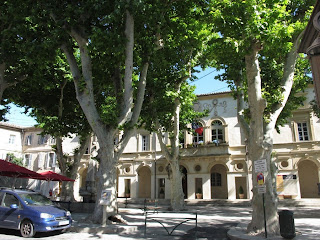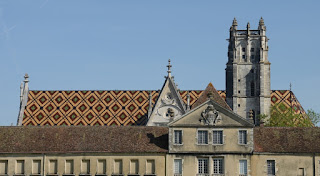We left Grenoble still heading south into the gorges in the Vercors area. We picked up a route map in the tourist office in Villiard-de-Lans. Just south of the town the road enters the Gorges of the Bourne - a Michelin *** attraction. The road is at the base of the gorge - just hollowed out at the base of the cliff and the height is not enough for tall vehicles but it makes a spectacular drive. Continuing on, the road circles the top of the Combe-Laval which gives quite a different perspective.
New style vehicle for La Poste.
The road along the Gorge de la Bourne near Villiard-de-Lans.
Looking down from the Combe Laval road.
We stayed in Vallance and the next day made an excursion to Rochemaure which has the standard ruined castle above the town and is where my Godson (Robert) has a house with magnificent views over the Rhone Valley. Not far to the west is Alba la Romaine with the remains of a Roman theatre. On the eastern bank of the Rhone is Montelimar famous for Nougat. When my Sister and I came here 45 years ago we nearly ate ourselves sick on the free samples of nougat. It was Sunday this time, and the nougat was more elusive.
Rochemaure - every town should have its own ruined castle standing guard.
Montelimar nougat in the traditional packaging - not the most economical way to buy it.
The following day Monday 24th June we left Vallance still heading south for our next stop Avignon. On the way we called into Orange. How many towns can boast of a well preserved Triumphal Roman Arch from 1stC A.D. in the middle of the roundabout as you enter the town? We also went to Vaison la Romaine which is on the tourist trail. A 1stC A.D. Roman bridge connects the Upper and Lower town on opposite banks of the river.
The Roman triumphal Arch now in the middle of a roundabout on the main road into Orange.
The upper town of Vaison la Romaine
Need a tagine? There is a good selection in Vaison la Romaine. I fancied a child's sundress in Provencal fabric, but there were only two sizes - six months and six years!
The following day our first stop was Saint-Remy-de-Provence. About 10 years ago we stumbled across a fabric shop while searching for the car which we had temporarily lost. I had kept the card and found it on the web recently, but when we got to Rue Lafayette it had gone. Fortunately there was another fabric shop on the opposite side of the street so I was able to buy "Tissus Provencal". Saint-Remy is a nice town to walk around with narrow lanes and interesting shops. Although the Mistral was blowing the streets were sheltered.
Many roads in France are lined with avenues of trees.
The Town Hall square in Saint-Remy-de-Provence with its shady trees and outdoor cafes is typical.
The fabric shop I found in Saint-Remy-de-Provence.
Inside the shop.
My purchases from the shop (and scraps given to me)
From there we went to Arles which has a lot of Roman ruins including an amphitheatre where French style bull fights (The bull lives) are held. However the attraction being advertised was Equestrian spectaculars - think Spanish Lippizaner Horses and I would have loved to see them in that setting. To finish the day we took a run out onto the Camargue - the Rhone Delta. There are large areas of rice paddies and it is flat and the Mistral was blowing hard making it not very pleasant. However we found some white horses although the flamingoes were mostly hiding.
The Roman Amphitheatre in Arles is still in use.
The white horses of the Camargue.
This morning in Avignon I thought I should get a photo of the famous half bridge but it proved rather difficult as there was little official parking along the river.
Sur le pont d'Avignon.
We are now in Rodez which we reached via the Tarn Gorges. From Rodez we made an excursion out to Villefranche-de-Rouergue one of the Bastide towns/villages. These were new towns built to a regular plan between 1220 and 1370 in South West France.
The road through the Tarn Gorges is also cut into the side of the cliffs.
More pretty wildflowers growing on the rocks.
A hillside town in the Tarn Gorge.
Street scene in Rodez. The dogs caught my eye, but as usual i was a bit slow snapping.
June is the end of the school year and the time for school excursions.
Around Rodez it is very pretty undulating countryside.
The central square next to the Collegiate church of Notre Dame in
Villefranche-de-Rouergue has the arcades typical of Bastide towns.
Examples of the choir stalls in the Collegiate church.
The cloisters of La Chartreuse Saint Saveur (just outside Villefranche) may be the largest in France, but they are very plain, not surprising as this was a Carthusian monastery.
Looking down on the village of Conques. Unfortunately by the time we got there it was too late to see the treasury - the largest collection of medieval reliquary gold and silverwork.































































